- Phone: +91-9596751936
- Email: jagdambaholiday@gmail.com
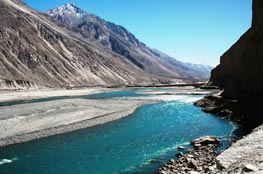
The Nubra Valley literally means the valley of flowers. Nubra Valley is situated in the north of Leh. The average altitude of the valley is about 10,000 feet above the sea level. The Khardong village, Khalser and Deskit are the main villages of Nubra valley. At first glance, the valley seems parched and dry, but this is prime farming land by Ladakhi standard.
Rangdum is situated about 130 kms south-east of Kargil and falls midway between Kargil and Padum. Due to its remoteness from inhabited parts either of Suru or Zanskar, this area of wild beauty is almost haunting, while its isolation is near perfect even as the unpaved Zanskar road traverses its length. The chief attraction of this area is an imposing 18th century Buddhist monastery with about 40 monks in residence.
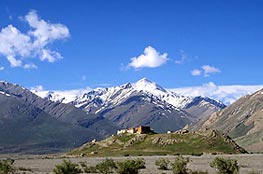
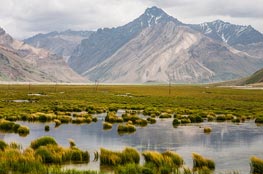
The Suru Valley forms the mainstay of Kargil district. Lying nestled along the north-eastern foothills of the great Himalayan Wall, it extends from Kargil town, first southward for a length of about 75 kms Upto the expanse around Panikhar, hence eastward for another stretch of nearly 65 kms upto the foot of the Penzila watershed where the Suru valley rises.
It has become famous as the second coldest inhabited place in the world by virtue of the intense cold that descends upon the valley along with repeated snowfalls during winters. Winter temperature is sometimes known to plummet to less than minus 40 degrees. The Drass valley starts from the base of the Zojila pass, the Himalayan gateway to Ladakh. For centuries its inhabitants are known to have negotiated this formidable pass even during the most risky period in the late autumn or early spring, when the whole sector remains snow-bound and is subject to frequent snow storms, to transport trader's merchandise across and to help stranded travellers to traverse it.
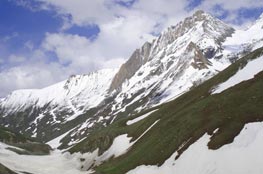
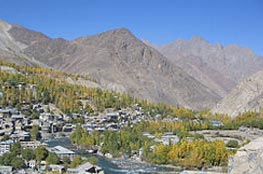
It is situated about 204 kms from Srinagar in the west and 234 kms from Leh in the east, is the second largest urban centre of Ladakh and headquarters of the district of same name.The broad Kargil basin and its wide terraces are separated from the Mulbekh valley by the 12 kms. long Wakha gorge.The old bazaar displayed a variety of Central Asian and Tibetan commodities even after the cessation of the Central Asian trade in 1949 till these were exhausted about two decades back. The fine quality and the abundance of the woolens available at Kargil can be attributed to the long fleeced mountain goats in the area. The Buddhist monastery of Mulbek Gompa is one place that will surely sweep you off your feet with its fabulous frescoes and splendid statues.
The beautiful high altitude Pangong Lake is also another popular destination with trekkers. It is a picturesque route that covers Shey and Thikse with their interesting monasteries, before turning off into the side valley of Chemrey. It goes over the Chang - la , the pass over the Ladakh range which despite it height is not too difficult to tackle.
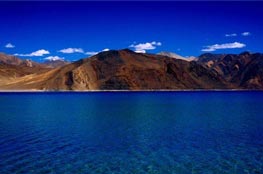

Buddhism, especially the Trans-Himalayan Buddhism from Tibet is the very essence of living in Ladakh. Partly because of the royal patronage, the central part of Ladakh has the greatest concentration of major Gompas or monasteries. Monasteries of Phyang, Hemis and Chemrey belong to the Namgyal dynasty period and are a major attraction during their monastic festivals. The reformist group monasteries are also well represented in central Ladakh by Thikse, Likkir, Rhidzong and Spituk. Buddhist study centers have been set up at both Leh and Choglamsar. Summer meditation sessions are held at the Mahabodhi Meditation Center on Changspa Lane. It is mainly along the course of this valley that about 10,000 strong, mainly Buddhists lives here. Within the mountain ramparts of this lost Shangrila stand a number of ancient yet active monastic establishments.
Once the capital of the ancient kingdom of Zanskar, Padum (3505 m) is the present day administrative headquarters of the region. With a population of nearly 1500, Padum can be described as the most populous settlement of Zanskar. Incidentally, it is only in Padum that there is a community of Muslims constituting nearly half of the population. Now, Padum has become famous as a major trekking base and a popular tourist destination. The nearest monument is a set of ancient rock carving on a huge boulder near the river bank, just below the old town. These date back to the 8th century and provide epigraphic evidence that the region was under the influence of North Indian Buddhism since ancient times.

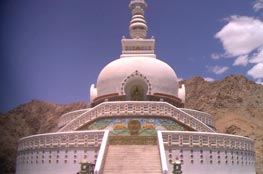
The monastery of Stongdey lies 18 kms. to the north of Padum, on the road leading to Zangla. Stondey was an old foundation associated with the Tibetan Yogi, Marpa, and is now the second largest monastic establishment of Zanskar, inhabited by 60 Gelukpa monks. The sprawling whitewashed complex has a number of temples, where each temple is a repository of the region's rich monastic legacy. Stongdey can be reached by foot in about 4 hours along the recently laid rough road. The climb up to the monastery is rather strenuous, but it is worth to enjoy the breathtaking scenery of the valley.
Lying deep in the northern arm of Zanskar at the end of the 35 km long rough road from Padum, Zangla was being ruled by a titular king till his death a few years back. The old castle now in ruins except from a small chapel, occupies a hill, overlooking the desert valley below. Nearby is the old nunnery which can be visited to know the austere life style of the small monastic community of nuns. The village lies mid-way between Stongdey and Zangla. Zangla is the nodal point on the popular Padum - Stongdey - Zangla - Karsha - Padum tour, which covers most of the cultural places of Zanskar. Zangla is also the take-off point for the Padum-Markha valley treks.
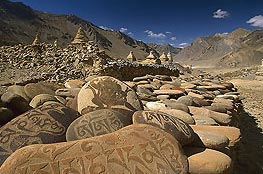
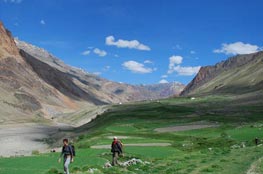
About 20 kms. south of Rangdum stands the Pazila watershed across which lies Zanskar, the most isolated of all the trans Himalayan Valleys. The Panzila Top (4401 m) is the picturesque tableland adorned with two small alpine lakes and surrounded by snow covered peaks. As the Zanskar road winds down the steep slopes of the watershed to the head of the Stod Valley, one of Zanskar's main tributary valleys, the majestic Drang-Drung glacier looms into full view. The Drang-Drung glacier is perhaps the largest glacier in Ladakh, outside the Siachen formation. It is from the cliff-like snout of this extensive glacier that the Stod or Doda River, the main tributary of river Zanskar, rises. Zanskar comprises of a tri-armed valley system lying between the Great Himalayan Range and the Zanskar mountain. The three arms radiate like star towards the west, north and south from a wide central expanse where the region's two principal drainage meet to form the main Zanskar River.
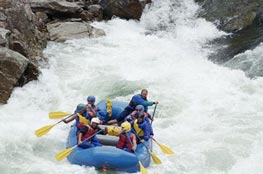
Exciting river rafting options are also available along the Indus river and its major tributaries in Ladakh. In recent years, rafting on the Indus river has become an attractive alternative to trekking and important part of the tour itinerary. Several agencies in Leh offers attractive rafting packages. The most difficult but exciting option for river rafting is on the Zanskar along its spectacular course through the gorge in the Zanskar mountains, between Padum and Nimo. Participants are required to be trained rafters themselves. Adequate arrangements for rescue coverage is an essential requirement before embarking upon the river rafting on Zanskar river.
Ladakh is the paradise for mountain climbing as there are so many peaks and mountains to climb. Climbing and conquering the lofty peaks of Ladakh needs extreme fitness.The area most frequented by foreign climbers is the Nun-Kun Massif in the Great Himalayan Range. Its easy accessibility from the Kargil-Padum road and the shortest possible approach to the base camps makes this massif the most attractive climbing destination in the Great Himalayas.
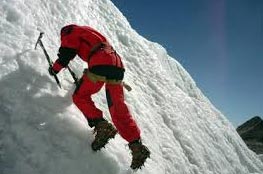
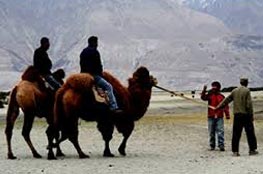
Camel, also known as the Ship of desert, is the major mode of transportation in desert. They are also known as the lifeline for the desert people.Many people who know that camel Safari is taken only in the hot deserts of Rajasthan, will be surprised to know that camel safari is carried out in the cold deserts of Ladakh also. Tourists can enjoy the soft adventure of camel safari in Ladakh in the months of July, August and September.
Trekking possibilities include short, day-long walks up and down mountain slopes to visit isolated villages or monastic settlements, or across a ridge to enjoy the sheer beauty of the mountains or long, trans mountain treks involving weeks of walking and camping in the wilderness.In recent years, parts of the Ladakh range between the Indus and Shayok valleys have also become available for trekking. The traditional trekking season extends from early June to mid-October. But localized treks within the Indus Valley can be undertaken even in May.
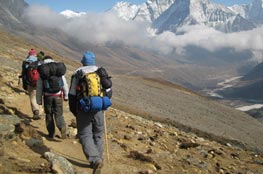
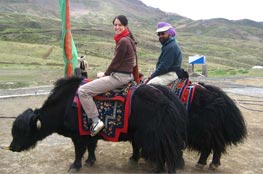
The Yak Safari is a unique safari in Ladakh. It is an experience unique to Ladakh. Exploring lakes, glacial valleys, gurgling streams, cascades, chiselled snow peaks, meadows and forests on yak can be a lifetime experience. Yak (dong), a wild ox is the largest animal of the cold desert. Yak was first described only a century ago by the famous Russian naturalist and explorer, N. M. Przewalski as most imposing than its placid domestic counterpart. Yak is immensely shaggy and weighs about a ton. It has curved horns whose tips can be as wide apart as 90 cm. and measure 76 cm. over the curves.
Every day presents an opportunity to visit new and exciting places in the land of barren wilderness and interact with culturally diverse people. The roads are not so good and provide a rough driving experience. The jeep safari through Ladakh is an excellent way to explore the remote region and it is one of the popular adventure activities in Ladakh. The pretty landscapes in and around Ladakh beckon nature lovers and adventure seekers alike. The desolate mountains of this high altitude desert and deep ravines reveal the natural beauty of Ladakh.
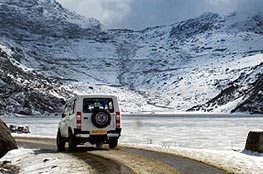
©2024 Jagdamba Holidays Tour & Travels. Powered by : Ideogram Technology Solutions Pvt. Ltd.